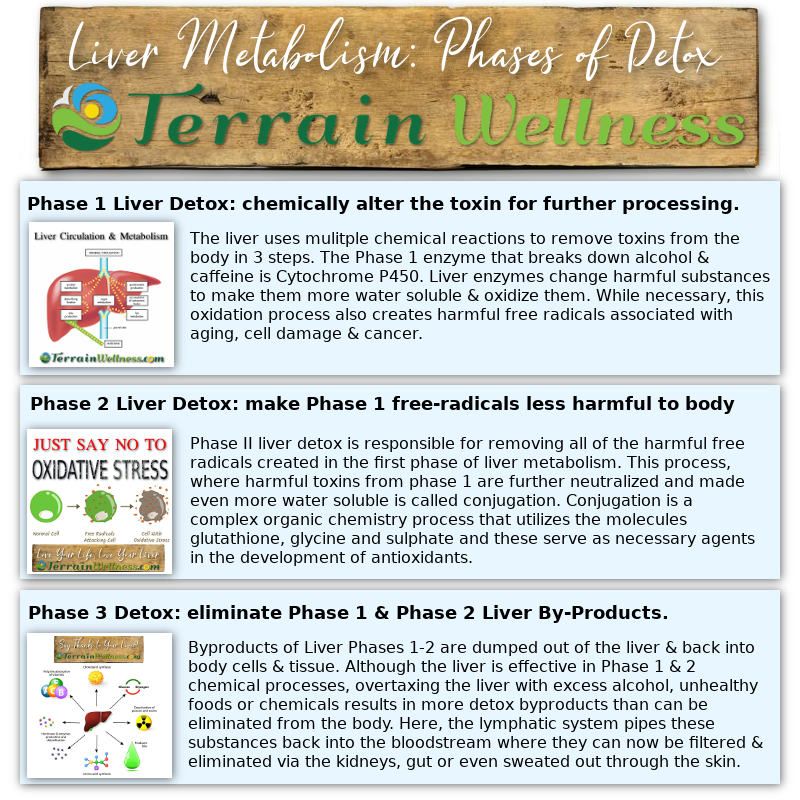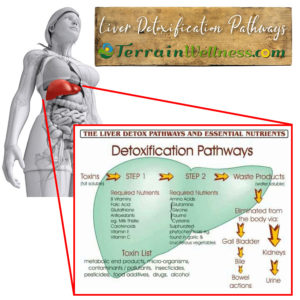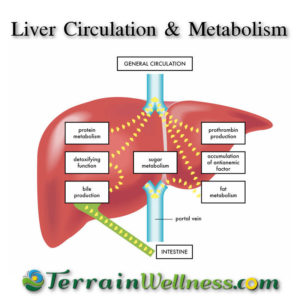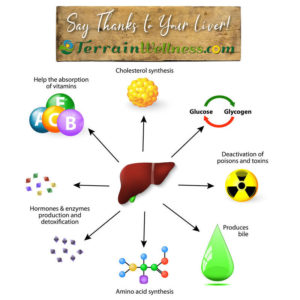
Today we’re explaining the process of how the liver removes toxins from the body in a complex series of chemical reactions. In our practice of naturopathic, acupuncture and primary care medicine in Portland, Oregon, one of the most common issues we see in patients are thyroid, estrogen and testosterone imbalances. While it may be tempting to simply glance at a lab report and prescribe a thyroid hormone, we have found much better results by examining in-depth lab reports and treating the underlying imbalances that so often lead to thyroid dysfunction in the first place.
To that end, this month we will focus on liver detoxification pathways, gut health and the lymphatic system. These fundamental processes that take place in the liver influence hormone health. There are three major phases of detoxification that your body undergoes. The first two take place in your liver and the third is accomplished by multiple organs systems, namely your gut, kidneys and lymphatic system.

The Phases of Liver Detoxification:
Phase I Liver Detoxification: chemically alter the toxin to prepare it for further processing.
-
When the body encounters toxic substances such as alcohol, pharmaceutical drugs and other by-products from the body’s activity, these substances have to go through multiple chemical reactions before they can be filtered out and removed from the body. The first step is known as Phase I liver detoxification (metabolism) and it involves multiple enzymes. As an example, the Phase I enzyme involved in the breakdown of alcohol and caffeine is called Cytochrome P450. This and other liver enzymes change harmful substances and make them more water soluble and/or oxidize them. Although necessary, this oxidation process is in fact the creation of harmful free radicals associated with aging, cell damage and some cancers.
Phase II Liver Detoxification: render the Phase I free-radical toxins less harmful and release them back into the body.
-
Phase II liver detox is responsible for removing all of the harmful free radicals created in the first phase of liver metabolism. This process, where harmful toxins from phase 1 are further neutralized and made even more water soluble is called conjugation. Conjugation is a complex organic chemistry process that utilizes the molecules glutathione, glycine and sulphate and these serve as necessary agents in the development of antioxidants. On a side note, those who receive IV therapy from us may already have put the pieces together and realized that liver detox is why glutathione is included in many of our infusion packages. Glutathione, along with other “antioxidants”, help break down the harmful oxidized substances that were in Phase I liver detox described above.
Phase III Detoxification: elimination of Phase I-II Liver By-Products.
-
The products from Phase 1 and Phase 2 liver detoxification pathways are released back into the bloodstream where these chemicals diffuse into the body’s cells and interstitial tissue, which can be problematic. Although the liver is effective in Phase 1 & 2 chemical processes, overtaxing the system at any point via excessive use of alcohol, unhealthy foods or environmental exposure results in more detox byproducts than can be eliminated from the body. This Phase III backup results in a buildup of oxidized waste-products known as free-radicals that damage cells, cause inflammation and other disease processes. Unfortunately, the liver dumps its waste by-products back into the body, where the body’s tissues where cells are again exposed to them. At this point, the lymphatic system takes over and pipes these substances back into the bloodstream where they can now be filtered and eliminated via the kidneys, gut or even sweated out through the skin. The lymphatic system is also responsible for making the immune system’s Lymphocytes (white blood cells). Since the lymphatic system drains out waste by-products and also has crucial immune system functions, it’s no surprise that lymphatics overburdened with harmful byproducts is less effective at fighting off infections.
Thanks for reading. We hope you found this article helpful.
Yours in Health, Terrain Wellness




